Gluten Free Home Brewing Blog
Brew In A Bag: A Few Batches Later
Updated 10.21.17!
In September we posted the blog ‘Brew In A Bag: Brew Day Notes To Self’ where we described our first experience of brewing in a bag. At that time we wanted to do a few things: use the BIAB method, compare aeration methods, and work on developing a new recipe. Well, a few things stood out after our first experience. We brewed in our kitchen and did not anticipate the difficulties we had maintaining a boil on our electric stove. We have since figured out that there is a small range, on our electric stove anyway, between ‘9’ and ‘High’ that can maintain a reasonable rolling boil. Below ‘9’ did not cut it. Our poor boil attributed to a lot of sediment and trub. We also found the BIAB method increased the amount of sediment and trub as compared to using a mash tun. The grain bill does a great job filtering sediment from ever entering the wort. But as the BIAB method consists of mashing malt in a bag, it does a poor job producing a clean wort. Lastly, and what would turn out to be more importantly, we had no idea as to the absorption rate of gluten free malts.
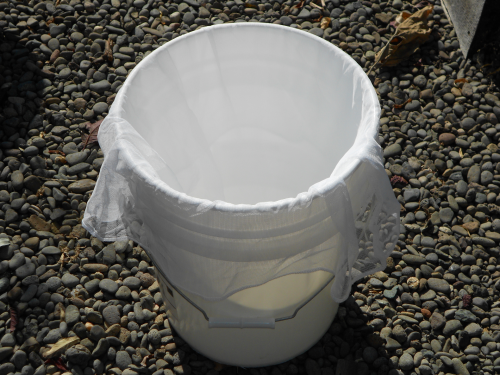
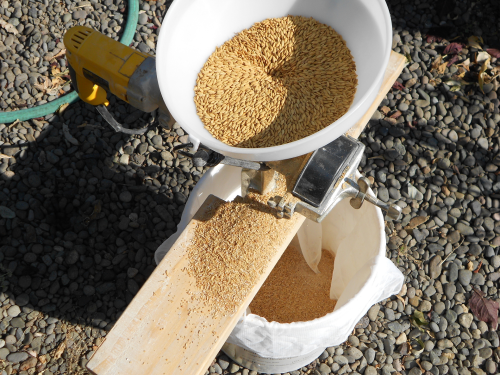
We learned that a good trick is to line the BIAB bag into the bucket which you will be milling your malt. Then all you have to do is pick up your bag of malt and submerge it in your strike water. There will be a small amount of starches in the bottom of the bucket that can then be added to the strike water. We still used a false bottom although we found no need to ever turn the heat source back on. We were able to maintain the target mash temperature for the first 70 of our 90 minute mash time. And it only dropped a couple degrees after that. But, we have an aversion to scorching grain bags on the bottom of brew kettles so opted to use our false bottom anyway.
Trust the math! When brewing with a cooler mash tun there is a little bit of learning your equipment and environment that goes into brewing. Specifically, the ambient temperature of everything that comes into contact with the strike water. The way you get to a target mash temperature is calculating your strike water temperature and the ambient temperature of your malt, mash tun, false bottom, and anything else that touches the strike water. The colder objects will absorb the heat from the strike water until everything is the same temperature. Your math better account for everything or you will miss the target mash temperature. BIAB is not so extreme. The only thing you introduce to your strike water is the bag of malt. The strike water is heated in the same kettle (including false bottom if you use one) that you will conduct your mash. Therefore there is minimal heat loss.
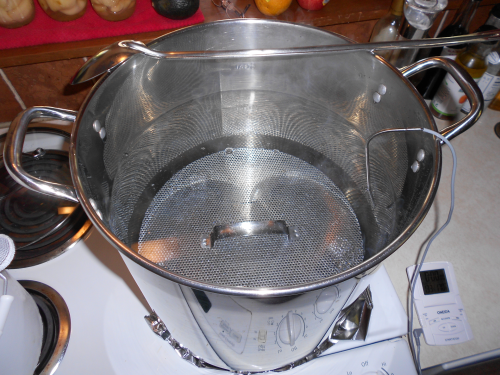
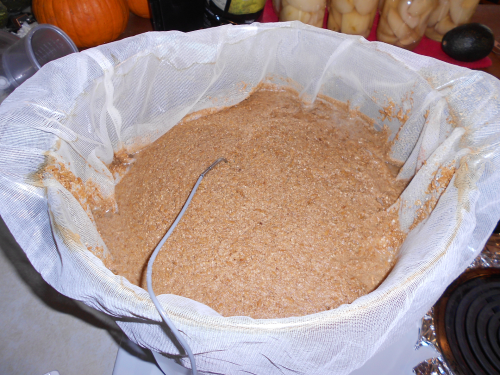
What is important with the BIAB method is the grain absorption rate of your malt! This is where our efforts have been focused as the grain absorption rate of gluten free malts are currently unknown. So because this specific variable is so crucial to the BIAB method, it is also a good method to ascertain the grain absorption rates of the various gluten free malt. We are getting closer to figuring out rice malt as we write this blog because we are also brewing right now. Looks like our calculations are still a bit off and we will have to brew again on another day. After we figure out rice malt we will move on to millet malt. But millet malt presents another problem. We have figured out that it is the rice hull that absorbs the majority of the water. Rice hulls are added to millet, buckwheat and corn to provide filtration and circulation and avoid a stuck mash. So we will have to decide on a percentage of the grain bill that will consist of rice hulls to conduct our experiment. The use of rice hulls varies from 10 to 25% depending on the recipe. Even our own recipes, depending on when they were developed, will vary in how much rice hulls are used.
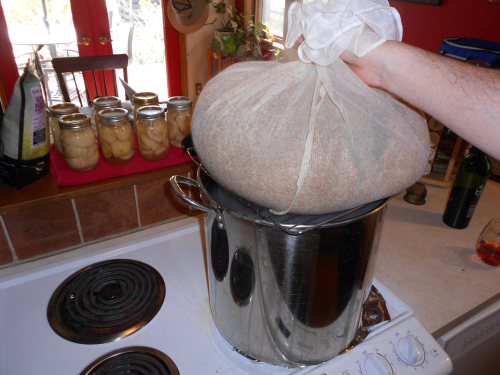
10.21.17 Update: Today we increased the trub volume calculations as the BIAB method makes a lot more of it. But we also totally over shot our preboil volume. The really curious and possibly very important observation that we made is that the efficiency of our conversion crashed, and when comparing our BIAB brewing notes, has consistently decreased as our strike water volume increased. We are going to recreate this poor efficiency and also use the same grain bill in a much thicker mash to see if the efficiency pops back up. It is too soon to tell, but the BIAB method may not be ideal for GF brewing. Conventional thought is that a thinner mash can increase efficiency. But we have also read that a thin mash decreases starch and protein breakdown, and dilutes and/or doesn't protect the enzymes as well. It has been a hair pulling kind of brew day!
Look for our next BIAB blog update…cheers!